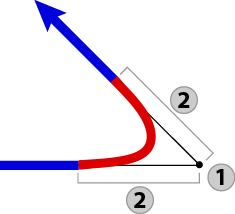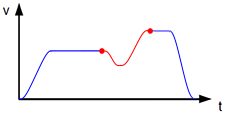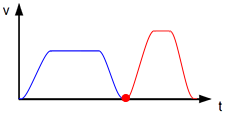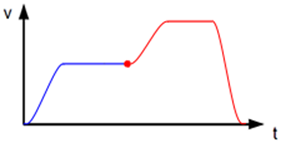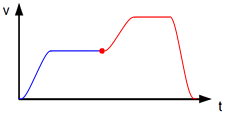S-Curve Corner Line-to-Line Transitions
This topic describes the behavior when both moves are linear the current and next moves are shortened using the S-Curve Corner transition mode.
- The amount each linear move is shortened is specified by the corner distance.
- A spline with continuous acceleration is used to connect the two linear moves.
- This allows for a smooth transition.
- See n-Degree: Transition.
n-Degree: Transition
|
Motion Path - Line-to-Line |
Key |
Motion Velocity Profile |
|---|---|---|
|
Blue: Incoming and outgoing linear motion. Red: Transition arc.
|
Special Case Transitions
These are the special cases for line-to-line transitions:
180-degree Transition
- The current move is shortened by the corner distance when the next move travels in the opposite direction.
- The velocity drops to zero between the two moves.
- The new move is in the opposite direction as the old move.
- The velocity drops to zero to avoid large accelerations and jerks to the axes.
|
Motion Path - Line-to-Line |
Key |
Motion Velocity Profile |
|---|---|---|
|
Blue: Incoming linear motion. Red: Outgoing linear motion.
|
Zero-degree Transition
- The path remains unchanged.
- The corner distance does not affect the path or velocity profile.
- A transition element is not inserted.
- The velocity blending acts like BM_BLENDING_PREVIOUS is being used.
- The new move continues in same direction as old move - continuous behavior.
- No transition segment is inserted.
|
Motion Path - Line-to-Line |
Key |
Motion Velocity Profile |
|---|---|---|
|
Blue: Incoming linear motion. Red: Outgoing linear motion.
|
Zero-distance Transition
- The path remains unchanged and a transition element is not inserted.
- The velocity blending acts like BM_BLENDING_PREVIOUS is being used.
- Motion passes the first move's endpoint.
- No transition segment is inserted.
- A sudden change in the direction of motion may result in large jerks to the axes.
|
Motion Path - Line-to-Line |
Key |
Motion Velocity Profile |
|---|---|---|
|
|
Blue: Incoming and outgoing linear motion. Red: Zero distance transition move.
|
